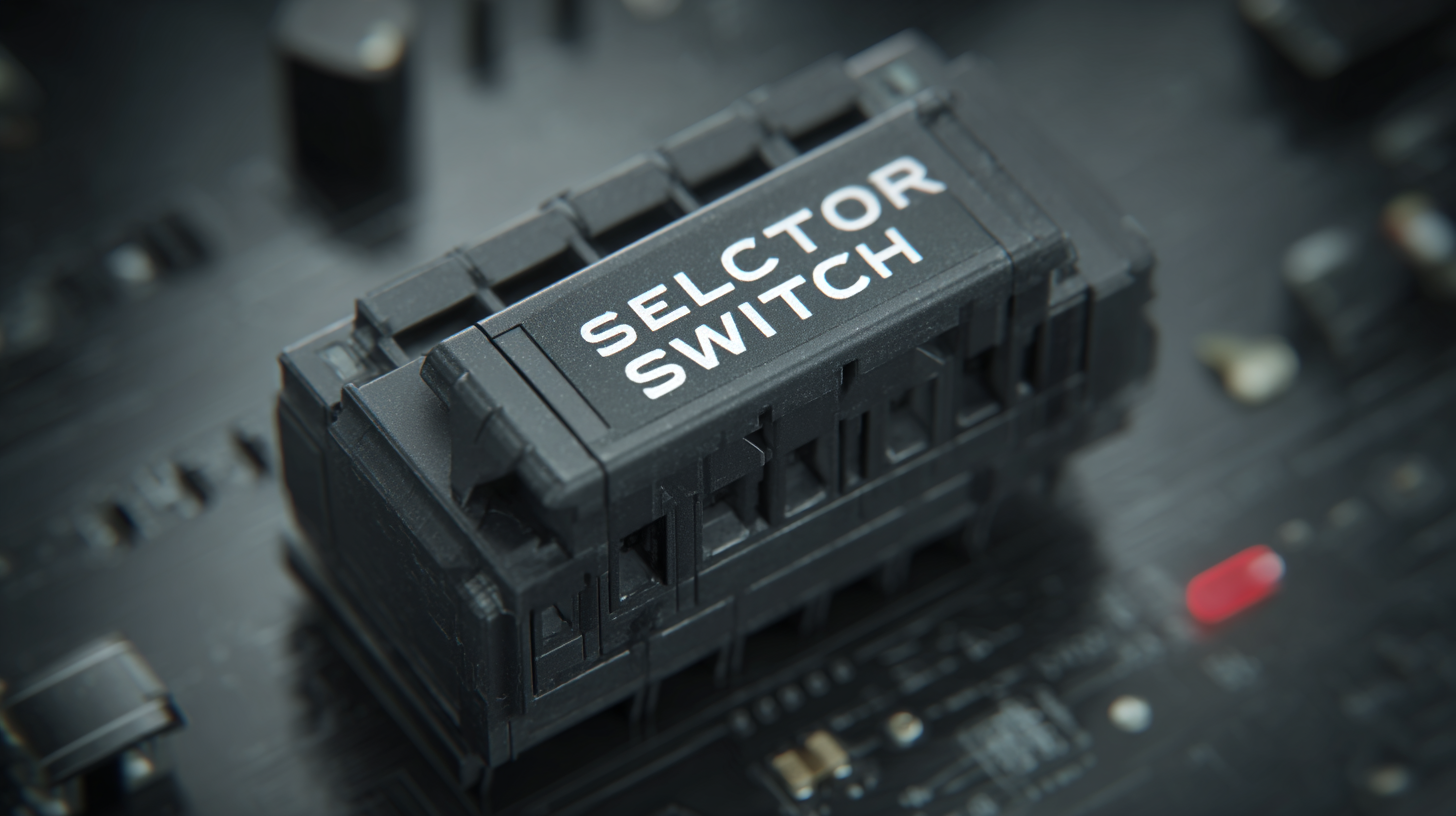
Mastering the Selection Process for the Best Selector Switch to Boost Your Manufacturing Efficiency
In the fast-paced world of modern manufacturing, the selection of key components can significantly impact operational efficiency, with the selector switch being a prime example. According to a recent industry report by MarketsandMarkets, the global market for selector switches is projected to reach $1.2 billion by 2026, growing at a CAGR of 5.2% from 2021. This growing demand underscores the critical role of selector switches in optimizing machinery and control systems. As manufacturing processes become increasingly automated, having the right selector switch not only enhances control and flexibility but also minimizes downtime and increases productivity.

This blog aims to provide insights and tips for mastering the selection process of the best selector switch, helping manufacturers navigate the myriad options available and ultimately boost their manufacturing efficiency.
Understanding Selector Switch Types: Key Comparisons for Manufacturing
When selecting the right selector switch for your manufacturing operations, understanding the various types available is crucial.
 Selector switches can greatly enhance control systems in manufacturing setups, allowing operators to manage machinery and processes more efficiently. Knowing the differences between momentary and maintained action switches, as well as rotary versus toggle designs, can help in making an informed decision that suits specific operational needs.
Selector switches can greatly enhance control systems in manufacturing setups, allowing operators to manage machinery and processes more efficiently. Knowing the differences between momentary and maintained action switches, as well as rotary versus toggle designs, can help in making an informed decision that suits specific operational needs.
Tip: Consider the environment where the selector switch will be used. If your manufacturing area has exposure to dust, moisture, or extreme temperatures, opt for switches with appropriate ratings to ensure reliability and longevity.
Furthermore, the choice of actuator style—be it a key, push button, or knob—can significantly influence usability. A user-friendly design will not only streamline operations but also reduce the likelihood of errors, ultimately leading to improved productivity.
Tip: Test potential switches under actual working conditions before full-scale implementation. This trial can reveal whether the switch’s performance meets your operational requirements and assists in training staff effectively.
Evaluating Performance: How Different Selector Switches Enhance Efficiency
When it comes to improving manufacturing efficiency, the choice of selector switch can make a significant difference. Different types of selector switches can enhance operational performance by offering various functionalities tailored to specific applications. For instance, a key selector switch can enforce security and prevent unauthorized access to certain machinery, while a rotary switch allows for easy and rapid cycling through operational modes. By understanding the unique benefits of each switch type, manufacturers can optimize their workflows and minimize downtime.
Moreover, evaluating the performance of selector switches requires a closer look at their durability and user interface. High-quality selection switches are designed to withstand harsh industrial environments, ensuring longevity and reliable operation. Furthermore, an intuitive interface can drastically reduce the learning curve for factory personnel, allowing them to adapt quickly and efficiently to changing production needs. By focusing on these performance metrics, businesses can select the best switches that not only meet their operational requirements but also contribute to a smoother and more efficient manufacturing process.
Cost vs. Quality: Making the Right Investment in Selector Switches
When it comes to choosing selector switches for manufacturing, the age-old debate of cost versus quality comes into play. While budget constraints can tempt manufacturers to opt for cheaper options, it's crucial to consider the long-term implications of this decision. Lower upfront costs frequently result in increased maintenance needs, reduced efficiency, and ultimately, the potential for costly downtime. Thus, investing in quality selector switches often proves to be more beneficial in the long run, ensuring smoother operations and enhanced reliability.
Quality selector switches not only enhance the performance of manufacturing processes but also contribute to worker safety and satisfaction. High-quality switches are designed to withstand the rigors of industrial environments, providing consistent performance where it counts. Additionally, manufacturers that prioritize quality often find that their employees experience less frustration from equipment failures, fostering a more productive work atmosphere. In balancing cost and quality, organizations must recognize that the right investment in high-quality selector switches can significantly boost overall manufacturing efficiency while minimizing unforeseen expenses related to inferior products.
Application Scenarios: Choosing the Ideal Selector Switch for Your Needs
When selecting the ideal selector switch for your manufacturing operations, understanding its application scenarios is crucial. Selector switches are vital components in industrial control systems, often influencing operational efficiency. According to a report by MarketsandMarkets, the global market for selector switches is projected to reach $1.9 billion by 2025, driven by the growing automation trends across various industries. Different applications, such as machinery control, lighting systems, and conveyor operations, necessitate distinct features in selector switches, including durability, operational ease, and compatibility with existing systems.
**Tip:** Before making a purchase, analyze your specific application needs. Consider factors such as frequency of use, the environment (e.g., temperature, humidity), and the level of operator interaction. A robust switch may be necessary for a high-frequency environment, while a more straightforward option could suffice in less demanding applications.
When assessing your options, take into account the configuration of the selector switch. Some industries may benefit from multi-position switches, enabling quick selection between several operational modes. A report from Grand View Research indicates that the need for increased operational flexibility is causing a shift towards customizable selector switches, highlighting the importance of adapting your choice to fit your manufacturing processes.
**Tip:** Evaluate the compatibility of selector switches with your existing systems. Ensure that they meet industry safety standards and verify if they provide feedback that aids in error reduction during operation.
Mastering the Selection Process for the Best Selector Switch to Boost Your Manufacturing Efficiency
| Application Scenario | Ideal Selector Switch Type | Key Features | Recommended Rating | Typical Use Cases |
|---|---|---|---|---|
| Industrial Machinery Control | Rotary Selector Switch | Durable, Multi-position, Ergonomic design | 10A, 250V | Conveyor systems, CNC machines |
| HVAC Systems | Key Selector Switch | Weather proof, Lockable, Compact | 5A, 125V | Thermostat control, Fan speed control |
| Automated Production Lines | Toggle Selector Switch | Heavy-duty, Quick response | 16A, 400V | Robotic systems, Assembly lines |
| Safety and Security Systems | Push Button Selector Switch | Emergency stop, High visibility | 10A, 250V | Alarm systems, Access control |
| Testing and Measurement Equipment | Slide Selector Switch | Precision control, Compact size | 1A, 50V | Multimeters, Oscilloscopes |
Safety Features: Comparing Selector Switches for Enhanced Industrial Protection
In the world of industrial manufacturing, the safety of equipment and personnel is paramount. When selecting a selector switch, one of the critical features to consider is its safety attributes. Different models boast varying levels of protection, such as emergency stop capabilities and protective housings that guard against accidental activation. A thorough comparison of these features can lead to informed decisions that significantly enhance industrial safety.
Moreover, modern selector switches are designed to comply with rigorous international standards, ensuring that they can withstand harsh environments. Factors such as ingress protection (IP rating) and temperature resistance are essential in selecting the right switch for your operation. Evaluating these aspects not only enhances the reliability of your manufacturing processes but also contributes to a safer work environment. By prioritizing safety features in your selection process, you can ensure that your manufacturing operations run smoothly and securely, ultimately driving efficiency.

